Geisha
Geisha (芸者) (/ˈɡeɪʃə/; Japanese: [ɡeːɕa]),[1][2] geiko (芸子), or geigi (芸妓) are female Japanese entertainers who perform traditional Japanese artforms, such as traditional dance and singing. They are characterised by their distinct appearance of long, trailing kimono, traditional hairstyles and the oshiroi makeup they wear.

Contrary to popular belief, geisha are not sex workers - a misconception in the West originating from foreigners confusing geisha with oiran (courtesans) and other sex workers, all of whom historically wore kimono, despite the differences in their styles of dress and appearance.
Terms
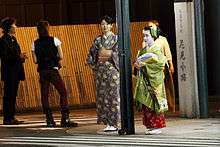
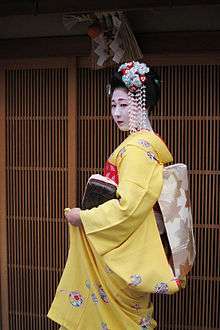
The word "geisha" consists of two kanji, 芸 (gei) meaning "art" and 者 (sha) meaning "person" or "doer". The most literal translation of "geisha" in the English language would be "artist", "performing artist" or "artisan". Another regional term for geisha with a slightly different meaning is "geiko", a term used to describe geisha in Western Japan, including Kyoto and Kanazawa. This term directly translates as "woman of art", and is part of the Kyoto dialect spoken by geisha in Kyoto and Western Japan.
Apprentice geisha are known as maiko (舞妓), a term translating to "woman of dance". In some regions of Japan such as Tokyo, apprentices are known instead as han-gyoku (半玉), meaning "half-jewel", referring to one of the terms for a geisha's wages - "jewel money".[3][4] The two stages before an apprentice officially debuts as a maiko are known as shikomi (仕込みさん, "preparation" or "training"), followed by a minarai (見習い, "learning by observation") period.[5] During the minarai period, an apprentice will receive training through one specific teahouse, referred to as the minarai-jaya.
A number of terms are used to describe the profession and community that geisha both live and work in. Though each has its own distinct meaning and translation, some are used interchangeably to describe the geisha community on the whole, such as hanamachi and karyūkai.
- Karyūkai - lit., the "flower and willow world" (花柳界). Before the decline and eventual disappearance of oiran, this term referred to the entertainment districts (and overall "world") of both geisha and courtesans - oiran were the "flowers" in this phrase, ostensibly for their beautiful and showy appearance, with geisha being the subtler and more graceful "willows".[6]
- Hanamachi - lit. "flower town" (花街), the district where a geisha works, is affiliated, and potentially lives. Geisha generally do not work outside of their hanamachi, though customers may call them for special occasions in other districts, or on excursions - however far away - to places outside the karyūkai. Engagements not held in licensed restaurants, teahouses or a geisha's own hanamachi are known as todē, "distant outings".[4]:204
- Kagai - lit., "five flower towns" (五花街). The five geisha districts of Kyoto; Gion Kobu and Gion Higashi, Ponto-chō, Miyagawa-chō and Kamishichiken. Kyoto previously had six hanamachi, with Shimabara, formerly a red light and geisha district, still being considered an active hanamachi as of 1970. In the present day, Shimabara is active only as a host for tayū re-enactors.[7]
- Mizu shōbai - lit., "water business" (水商売). A euphemistic term previously used to describe the entertainment and red-light districts in Japan. In the present day, the mizu shōbai refers exclusively to the world of geisha and kabuki actors.[4]
Though geisha may not live within their hanamachi in day-to-day life, all geisha must be affiliated with an 置屋 (okiya) - a geisha lodging house. Okiya are usually run by women, many of whom are ex-geisha themselves.[4] Though geisha may entertain guests within their okiya and at restaurants or inns, they will usually work at an ochaya (お茶屋, lit., "teahouse"). Geisha will usually take engagements for part or the whole of an evening referred to as ozashiki (お座敷) - a term that combines the name for a banqueting room, zashiki (茶屋) and the honorific suffix "o-" (お), changing the meaning to a term exclusively referring to the engagements a geisha takes.
History
Origins
In the early stages of Japanese History, saburuko (serving girls) were mostly wandering girls whose families had been displaced by war. Some of these saburuko girls offered sexual services for money while others with a better education made a living by entertaining at high-class social gatherings.
After the imperial court moved the capital to Heian-kyō (Kyoto) in 794, conditions that would form geisha culture began to emerge, as it became the home of a beauty-obsessed elite.[8] Skilled female performers, such as shirabyōshi dancers, thrived.
Traditional Japan embraced sexual delights and men were not constrained to be faithful to their wives.[9] The ideal wife was a modest mother and manager of the home; by Confucian custom, love had secondary importance. For sexual enjoyment and romantic attachment, men did not go to their wives, but to courtesans.
Walled-in pleasure quarters known as yūkaku (遊廓、遊郭) were built in the 16th century,[10] and in 1617 the shogunate designated "pleasure quarters", outside of which sex work was illegal to practice,[11] where yūjo (lit., "woman of pleasure") would be classified and licensed. The upper ranks of yūjo were commonly referred to as oiran, a category with its own individual ranks, the highest of which were the tayū. Oiran, whilst still sex workers, also included performances of the traditional arts as a part of their entertainment, their practice of which often differed considerably from those of geisha.
Some yūjo also performed theatrical plays, dances and skits; one such person was Izumo no Okuni, whose theatrical performances on the dry riverbed of the Kamo River are considered to be the beginnings of kabuki theatre.[11]
18th-century emergence of the geisha
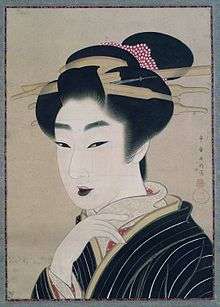

The pleasure quarters quickly became glamorous entertainment centers that offered additional services other than sex. The highly accomplished courtesans of these districts entertained their clients by dancing, singing, and playing music. Some were renowned poets and calligraphers as well; the development of the cultural arts of the pleasure quarters led to the rise in oiran being considered to be the celebrities of their day.
The first geisha performing for guests of the pleasure quarters appeared near the turn of the eighteenth century; these geisha were men, who would entertain the customers of courtesans through song and dance, often travelling between courtesan parties to do so.[11] The forerunners of the female geisha were the teenage odoriko ("dancing girls")[12] who were trained as chaste dancers-for-hire.
In the 1680s, odoriko were popular entertainers paid to perform in the private homes of upper-class samurai,[13] though many had turned to sex work by the early 18th century. Those who were no longer teenagers (and could no longer style themselves odoriko[14]) adopted other names — one being "geisha", after the male entertainers.
The first woman known to have called herself "geisha" was a Fukagawa sex worker, in about 1750.[15] She was a skilled singer and shamisen player named Kikuya who was an immediate success, making female geisha extremely popular.[16] As they became more widespread throughout the 1760s and 1770s, many began working only as entertainers rather than sex workers, often in the same establishments as male geisha.[17]
Geisha in the 19th century to present day
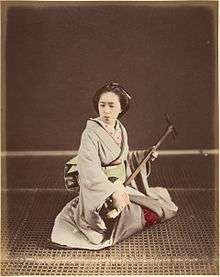
Geisha who worked within the pleasure quarters were strictly forbidden from selling sex. This was done to protect the business of the oiran (courtesans), who held high importance in the society at the time. Geisha were also forbidden from wearing particularly flashy hairpins or kimono, and if a courtesan accused a geisha of stealing her customers and business, an official inquiry and investigation would be opened.[4]
At various points throughout the Edo period, geisha were affected by reforms aimed at limiting or shutting down the pleasure quarters, confining them to work in "red light" districts such as Shimabara in Tokyo. However, these reforms were often inconsistent and were repealed at various times.
By 1800, the profession of geisha was understood to be almost-entirely female, despite the handful of male geisha who still entertain in modern day. While courtesans and sex workers existed to meet the sexual needs of men, their status as celebrities and fashion icons had waned considerably, as machi geisha (town geisha) began to successfully establish themselves as artists, entertainers, and more worldly female companion than their cloistered cousins in the red light districts of Japan.
This popularity was increased by the introduction of various edicts intended to regulate the lower classes - in particular, the merchant classes who patronised geisha, who were also seen as a "lower" class. Both had, over time, come to hold much of the purchasing power within Japan, and as such, set fashionable trends within society. As such, the tastes of the merchant classes for kabuki and geisha became widely fashionable and popular, and though specific edicts on dress were introduced to effectively neuter the appearances of geisha and their customers, this in turn led to the rise in popularity of more refined aesthetics within those classes.
Geisha had, in previous years, been legally prevented from dressing in the same expensive and extravagant manner that courtesans did, and the introduction of laws on dress only furthered their popularity as refined and fashionable companions for men. As a result, over time, courtesans of both higher and lower ranks began to fall out of fashion, seen as gaudy and old-fashioned where geisha were worldly and free in how they dressed. By the end of the 19th century, courtesans no longer held the celebrity status they once did.[18] This trend would continue until the criminalisation of sex work in Japan in 1956.
By the 1830s, geisha were considered to be the fashion and style icons in Japanese society, and were emulated by women of the time.[19] Many fashion trends started by geisha soon became widely popular, with some continuing to this day; the wearing of haori by women, for example, was first started by geisha from the Tokyo hanamachi of Fukagawa in the early 1800s.
There were considered to be many classifications and ranks of geisha, though some were colloquial or closer to a tongue-in-cheek nicknames than an official ranking. Some geisha would sleep with their customers, whereas others would not, leading to distinctions such as "kuruwa" geisha - a geisha who slept with customers as well as entertaining them through performing arts - yujō ("prostitute") and jorō ("whore") geisha, whose only entertainment for male customers was sex, and "machi" geisha, who did not, officially and in reality, sleep with customers at all.[20]
Pre-war and wartime geisha
World War II brought lasting change to the geisha profession; before the war, geisha numbers, despite seeing competition from jokyū (café girls, the pre-cursor to the bar hostess profession in Japan), had been as high as 80,000,[4]:84[21] however, following the closure of all geisha districts in 1944, mostly all geisha had been conscripted into the war effort proper, with many finding work in factories or elsewhere through customers and patrons.
Though geisha returned to the karyūkai relatively quickly post-war, many had decided to stay on in their wartime jobs, considering it to be a more stable form of employment than their employment in the hanamachi had been. Both during and after the war, the geisha name lost some status, as some sex workers began referring to themselves as "geisha girls" to members of the American military occupying Japan.[4]
Post-war geisha
In 1945, the karyūkai saw restrictions on its practices lifted with teahouses, bars, and geisha houses (okiya) allowed to open again. Though many geisha did not return to the hanamachi post-war, it was evident that working as a geisha was still considered to be a lucrative and viable career, with numbers increasing quickly. The vast majority of geisha post-war were aged 20–24, as many retired in their mid-twenties after finding a patron - a trend carried over from the pre-war karyūkai:
'I showed the mother of the Yamabuki [okiya, in 1975] some statistics on the age distribution of the geisha population in the 1920s. She remarked on the big dip in figures when women reached the age of twenty-five. "In those days, when you found yourself a patron you could stop working. If you were lucky you would be set up in your own apartment and have a life of leisure, taking lessons when you wanted to for your own enjoyment ... I think it's pretty unusual nowadays for a geisha to stop working when she gets a patron."'[4]:202–203
The status of geisha in Japanese society also changed drastically post-war. Throughout the 1920s and 1930s, much discussion had taken place surrounding the status of geisha in a rapidly-Westernising Japanese society. Some geisha had begun to experiment with wearing Western clothing to engagements, learning Western-style dancing, and serving cocktails to customers instead of sake. The image of a "modern" pre-war geisha had been viewed by some as unprofessional and a betrayal of the profession's image, but as a necessary change and an obvious evolution by others. However, the incumbent pressures of the war rapidly turned the tide against Westernisation, leading to an effective abandonment of the "Western-style" geisha experiments.
Post-war, geisha unanimously returned to wearing kimono and practicing the traditional arts, abandoning all experimental geisha styles. This, however, led to the final blow for the profession's reputation as fashionable in wider society; though the geisha did not experience the rapid decline and eventual death that courtesans had experienced in the previous century, they were instead rendered as "protectors of tradition" in favour of preserving the image geisha had cultivated over time.[4]
Nonetheless, in the decades after the war, the profession's practices still underwent some changes; following the introduction of the Prostitution Prevention Law in 1956, geisha benefited from the official criminalisation of practices such as mizuage, a practice that had at times been undertaken coercively or through force by some maiko in mostly pre-war Japan; despite this, the misconception of geisha being on some level sex workers and of mizuage being a common practice continues, inaccurately, to this day.[22]
After Japan lost the war, geisha dispersed and the profession was in shambles. When they regrouped during the Occupation and began to flourish in the 1960s during Japan's postwar economic boom, the geisha world changed. In modern Japan, girls are not sold into indentured service. Nowadays, a geisha's sex life is her private affair.[23]
From the 1930s onwards, the rise of the jokyū bar hostess began to overshadow geisha as the premiere profession of entertainment at parties and outings for men.[4]:84 In 1959, the Standard-Examiner reported the plight of geisha in an article written for the magazine Bungei Shunju by Japanese businessman Tsûsai Sugawara. Sugawara stated that girls now "prefer[red] to become dancers, models, and cabaret and bar hostesses rather than start [the] training in music and dancing at the age of seven or eight" necessary to become geisha at the time.[24]
Compulsory education laws passed in the 1960s effectively shortened the period of training for geisha apprentices, as girls could no longer be taken on at a young age to be trained throughout their teenage years. This led to a decline in women entering the profession, as most okiya required a recruit to be at least somewhat competent and trained in the arts she would later go on to use as a geisha;[25] by about 1975, okiya mothers in Kyoto began accepting both recruits from different areas of Japan in larger numbers, and recruits with little to no previous experience in the traditional arts. Before this point, the number of maiko in had dropped from 80 to just 30 between 1965–1975.[7]
By 1975, the average age of a geisha in the Ponto-chō district of Kyoto was roughly 39, with the vast majority being aged 35–49.[4] The population of geisha at this time was also surprisingly high, roughly equivalent to the numbers of young women within the profession; geisha no longer retired young when they found a patron, and were less likely than other women of the same age to have both children and an extended family to support them. In 1989, it was reported in the New York Times that there were an estimated 600-700 geisha left throughout the whole of Japan.[26]
Present day geisha

Modern geisha still live in okiya, particularly during their apprenticeship, and are legally required to be registered to one, though they may not live there everyday. Many experienced geisha are successful enough to choose to live independently, though living independently is more common in some geisha districts - such as those in Tokyo - than others.
Geisha are often hired to attend parties and gatherings, traditionally at tea houses or traditional Japanese restaurants (ryōtei).[27] The charge for a geisha's time, previously determined by the time it took to burn one incense stick (known as senkōdai (線香代) (lit., "incense stick fee") or error: {{nihongo}}: Japanese or romaji text required (help) (lit., "jewel fee")), was modernised during the 19th century to a flat fee charged per hour.[4] In Kyoto, the terms ohana (お花) and error: {{nihongo}}: Japanese or romaji text required (help) (both meaning "flower fees") are used instead as part of the Kyoto dialect. However, appointments and arrangements are still made by the mother of the house (okasan) through the official registry office ("kenban" (検番)), which keeps a record of both the appointments taken by a geisha and her schedule.
In modern Japan, geisha and their apprentices are a rarer sight outside of the hanamachi or chayagai (茶屋街, literally "tea house district", often referred to as "entertainment district"); most sightings of geisha and maiko in and around cities such as Kyoto are actually tourists who pay a fee to be dressed up as either a maiko or geisha for the day, a practice known as "henshin".[28]
Over time, the number of geisha, despite the efforts of those within the profession, has declined, in part due to the nature of the economy, declining interest in the traditional arts, the exclusive and closed-off nature of the karyūkai, and the expense of being entertained by geisha.[29] The number of maiko and geisha in Kyoto fell from 76 and 548 in 1965 respectively to just 71 and 202 in 2006[7] as a result.
However, following the advent of wider accessibility to the internet from the mid-2000s onwards, a greater number of recruits have decided to join the profession with no existing ties to the karyūkai through watching online documentaries and reading websites set up by okiya to promote their business;[28] documentary pieces commonly inspire young women to join the profession, such as the geisha Satsuki, who later became the most popular geisha in Gion for a seven-year period:
[Geisha] Satsuki first took an interest in the kagai [lit., "five geisha districts" - name for geisha quarters in Kyoto] while a middle school student in Osaka, at around the age of 14, after seeing a documentary about a maiko's training. “I already had heard of maiko, but it was when I saw the documentary that I thought – I want to do that.”[30]
In recent years, a growing number of geisha have complained to the authorities about being pursued and harassed by groups of tourists keen to take their photograph when out walking. As a result, tourists in Kyoto have been warned not to harass geisha on the streets, with local residents of the city and businesses in the areas surrounding the hanamachi of Kyoto launching patrols throughout Gion in order to prevent tourists from harassing geisha.[31]
Geisha districts
Geisha work in districts known as hanamachi - lit. "flower towns", and are said to inhabit the karyūkai - "the flower and willow world", a term originating from a time when both courtesans and geisha worked within the same areas. Courtesans were said to be the "flowers" in this moniker due to their showy and beautiful nature, with geisha being the "willows" due to their understated nature.
Part of the comparison between geisha and willows comes from the perceived loyalty amongst geisha to their patrons - over time, it became known that certain factions, such as certain political parties, would patronise some geisha districts with their rivals patronising others. Though courtesans (and by extension, sex workers) were humourously known for having loyalty only to the customer paying them for the night, a geisha would stand by her patrons and defend their best interests, her loyalty to her patrons being perceived as higher than her loyalty to her money.[4]
Historically, geisha on occasion were confined to operate in the same walled districts as courtesans and sex workers; however, both professions have on some level always maintained a distance officially, despite often being legislated against by the same laws.
Tokyo
The six hanamachi in Tokyo are Asakusa, Hachioji, Kagurazaka, Mukojima, Shinbashi, and Yoshicho.
Kyoto
The hanamachi in Kyoto are known for their adherence to tradition and high prestige, with the image of a Kyoto maiko typifying that of geisha culture within wider Japanese and international society.
In Kyoto, the different hanamachi - known as the gokagai (lit., "five hanamachi") - are seen as unofficially ranked. Gion Kobu, Ponto-chō and Kamishichiken are seen as the most prestigious,[32] with Gion Kobu at the top; below these three are Gion Higashi and Miyagawa-chō.[33] The more prestigious hanamachi are frequented by powerful businessmen and politicians.[11]
In the 1970s, the geisha districts in Kyoto were known as the rōkkagai (lit., "six hanamachi"), as the district of Shimabara was still officially active as a geisha district, as well as hosting tayū reenactors; however, no geisha are active in Shimabara in the 21st century, despite modern tayū continuing to work there.[34]
Regional hanamachi
Though regional hanamachi are typically not large enough to have a hierarchy, regional geisha districts are seen as having less prestige than those in Kyoto, viewed as being the pinnacle of tradition in the karyukai.
Geisha in onsen towns such as Atami may also be seen as less prestigious, as geisha working in these towns are typically hired to work in one hotel for travelling customers they are usually not familiar with before entertaining; nevertheless, all geisha, regardless of region or district, are trained in the traditional arts, making the distinction of prestige one of history and tradition.
Stages of training
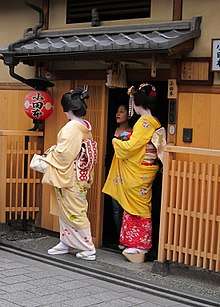
Before the twentieth century, geisha began their training at a young age, around the age of six. In the present day this is no longer the case, and geisha usually debut as maiko around the age of 17 or 18. Labour laws stipulate that that apprentices only join an okiya aged 18, although okiya in Kyoto are legally allowed to take on recruits at a younger age, 15–17.[35][36] Now, girls must graduate from middle school and then make the personal decision to train to become a geisha. Young women who wish to become geisha now most often begin their training after high school or even college. Many more women begin their careers in adulthood.[37]
Before debuting as a maiko, apprentices may live at the okiya as shikomi - essentially a trainee, learning all the necessary skills to become a maiko, as well as attending to the needs of the house and learning to live with her geisha sisters and within the karyūkai. By watching other geisha and learning from the mother of the house (known as the okā-san - lit., "mother"), apprentices learn how to speak with guests, the mannerisms necessary to be a geisha, and the traditions of the karyūkai. Apprentices also learn how to comfortably wear kimono.[38][27]
Traditionally the shikomi stage of training lasted for years, and some girls were bonded to geisha houses as children. Daughters of geisha were often brought up as geisha themselves, usually as the successor (atotori, meaning "heir" or "heiress") or daughter-role (musume-bun) to the okiya. Successors, however, were not always blood relations. Nowadays, a girl is often a shikomi for up to a year.
A maiko is an apprentice and is therefore bonded under a contract to her okiya. The okiya will usually supply her with food, board, kimono, obi, and other tools of her trade, but a maiko may decide to fund everything herself from the beginning with either a loan or the help of an outside guarantor.[4] A maiko's training is very expensive, and debts must be repaid over time with her earnings to either the okiya or her guarantor. This repayment may continue after graduation to geishahood, and only when her debts are settled can a geisha claim her entire wages and work independently (if loaning from the okiya). After this point she may chose to stay on living at her okiya, must still be affiliated to one to work, and even living away from the okiya, will usually commute there to begin her working evening.[4][8]
A maiko will start her formal training on the job as a minarai (learning by observation) at an ozashiki (お座敷) (a geisha party), where she will sit and observe as the other maiko and geisha interact with customers. In this way, a trainee gains insights into the nature of the job, following the typical nature of traditional arts apprenticeships in Japan, wherein an apprentice is expected to learn almost entirely through observation. Although geisha at the stage of minarai training will attend parties, they will not participate on an involved level and are instead expected to sit quietly. Trainees can be hired for parties, but are usually uninvited - though welcomed - guests, brought along by their symbolic older sister as a way of introducing a new trainee to patrons of the karyūkai. Minarai usually charge just a third of the fee a typical geisha would charge, and typically work within just one particular tea house, known as the minarai-jaya - learning from the "mother" (proprietress) of the house. The minarai stage of training involves learning techniques of conversation, typical party games, and proper decorum and behaviour at banquets and parties. This stage lasts only about a month or so.[39]
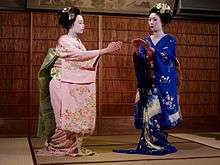
After the minarai period, a trainee will make her official debut (misedashi) and become a maiko. This stage can last between 3 and 5 years. During this time, they learn from both other trainees senior to them, and their geisha mentors, with special emphasis placed on learning from her symbolic "older sister" (onee-san). Though any maiko or geisha "senior" in rank to an apprentice may be called "older sister", an apprentice's official "older sister" is a geisha bonded to her in an official ceremony, who will thereafter typically teach her about working in the karyūkai. This involves learning how to serve drinks, hold casual conversation, and some training in the arts, though the latter is usually carried out through by dance and music teachers.

There are three major elements of a maiko's training. The first is the formal arts training, which takes place in schools found in every hanamachi. They study traditional instruments: the shamisen, the flute, and drums, as well as learn games,[40] traditional songs, calligraphy,[41] Japanese traditional dances (in the nihonbuyō style), tea ceremony, literature, and poetry.[42][43] The second element is the entertainment training which a trainee learns at various tea houses and parties by observing her "older sister". The third is the social skill of navigating the complex social web of the hanamachi; formal greetings, gifts, and visits are key parts of the social structure of the karyūkai, and crucial for the support network necessary to support a trainee's eventual debut as a geisha.
Around the age of 20–21, a maiko will graduate to geisha status in a ceremony known as erikae (turning of the collar).[44][45]
Following debut, geisha typically do not go through major role changes, as there are no more formal stages of training. However, geisha can and do work into their eighties and nineties,[35] and are still expected to train regularly,[46] though lessons may only be put on a few times a month. A geisha may decide to retire from her work, either to move away from the karyūkai, take on the role of "mother" of an okiya, or to mainly focus on performances and teaching other younger geisha.
Women in geisha society
Women in geisha society are recognised as some of the most successful businesswomen in Japan, with almost the entirety of the karyūkai being owned and run by women. New geisha are trained for the most part by their symbolic mothers and older sisters, and engagements are arranged through the mother of the house.[47][48]
Infrequently, men take contingent positions such as hair stylists,[49] dressers (known as otokoshi, as dressing a maiko requires considerable strength) and accountants. The heads (iemoto) of some dance and music schools that geisha train under, however, may be male, with some barrier to entry for women to achieve the legacy of being the head of an artistic school.[4]
The geisha system was founded, actually, to promote the independence and economic self-sufficiency of women. And that was its stated purpose, and it actually accomplished that quite admirably in Japanese society, where there were very few routes for women to achieve that sort of independence.
— Mineko Iwasaki in interview, Boston Phoenix[50]
Historically, the majority of women within Japan were wives who could not work due to familial duties. A geisha, however, could achieve independence by working to pay off her debts, making the profession one method for women to support themselves without becoming a wife.[51] Moreover, a geisha chosen as the heir (atotori) of a geisha house would have stable employment for much of her life, running the okiya throughout her career until the next generation.[51]
Over time, some Japanese feminists have seen geisha as exploited women, but some modern geisha see themselves as liberated feminists: "We find our own way, without doing family responsibilities. Isn't that what feminists are?"[52]
Geisha and male guests
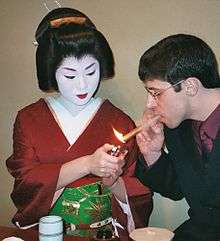
Historically, geisha held an appeal for mainly male guests as a woman outside of the role of "wife". Wives were modest, responsible, and at times sombre, whereas geisha could be playful and carefree. Geisha would, on occasion, marry their clients, but marriage required retirement as a matter of fact.
Though relatively uncommon in previous decades, geisha parties are no longer understood to be affairs for male guests exclusively, with women commonly attending parties alongside other male guests. Though geisha will still gracefully flirt and entertain male guests, this is understood to be a part of a geisha's hostessing and entertainment skills, and is not taken as a serious sign of personal interest.
Geisha and relationships
Despite long-held connotations between sex and geisha, a geisha's sex and love life is usually distinct from her professional life.
Geishas are not submissive and subservient, but in fact they are some of the most financially and emotionally successful and strongest women in Japan, and traditionally have been so.
— Iwasaki Mineko, Geisha, A Life[53]
Most geisha are single women, though they may have lovers or boyfriends over time, and are allowed to pursue these relationships outside of having a patron. In the present day, some geisha are married and continue to work in their capacity as geisha, despite it being uncommon; these geisha are likely to be based in regions outside of Kyoto, as its ultra-traditionalist geisha districts would be unlikely to allow a married geisha to work.
Geisha and sex work
Geisha have historically been conflated with sex work and commonly confused with sex workers, despite the profession being mostly forbidden from receiving payment for sex since its inception. Despite this, some geisha have historically engaged in sex work, either through personal choice, or through coercion and at times force.
In 1872, shortly after the Meiji Restoration, the new government passed a law liberating "prostitutes (shōgi) and geisha (geigi)", ambiguously grouping both professions together.[54] The terms of the law caused controversy, due to the unclear differentiation between each profession, with some officials claiming that sex workers and geisha worked different ends of the same profession, and that there would be little difference in calling all sex workers "geisha". Nonetheless, the government maintained an official distinction between both professions, arguing that geisha should not be conflated with or confused for sex workers.[55]
Though the law officially maintained a distance between geisha and sex workers, some geisha still engaged in sex work. Writing in 1956, former geisha Sayo Masuda wrote of her experiences in the onsen town of Suwa, Nagano Prefecture, where she was sold for her virginity a number of times by the mother of her okiya. Such practices could be common in less reputable geisha districts, with onsen towns in particular being known for their so-called "double registered" geisha (a term for an entertainer registered as both a geisha and a sex worker).[4] A geisha working to pay off her incumbent debts to the mother of the house often had little choice but to engage in sex work, whether forced to by her occupational "mother", or coerced to do it in order to pay off her debts.[3]
In 1956, and following its implementation in 1958, the Prostitution Prevention Law (Baishun-bōshi-hō) criminalised the vast majority of sex work, essentially leading to the outlawing of practices such as mizuage for geisha. In the present day, mizuage does not exist, and apprentices mark their graduation to geisha status with a series of ceremonies and events.
Despite this, the modern conflation between geisha and sex workers continues as a pervasive idea, particularly in Western culture. Sheridan Prasso wrote that Americans had "an incorrect impression of the real geisha world ... geisha means 'arts person' trained in music and dance, not in the art of sexual pleasure".[56] Similarly, K.G. Henshall stated that the job of a geisha included "[entertaining] their customer, be it by dancing, reciting verse, playing musical instruments, or engaging in light conversation. Geisha engagements may include flirting with men and playful innuendos; however, clients know that nothing more can be expected. In a social style that is common in Japan, men are amused by the illusion of that which is never to be."[57]
Danna partnership
In the past, it had been unspoken tradition for an established geisha to take a danna, or patron, who would pay for her expenses, buy her gifts, and engage her on a more personal level - at times involving sex - than a banquet or party would allow. This would be seen as a sign of the man's generosity, wealth and status, as the expenses associated with being a geisha were relatively high; as such, a danna was typically a wealthy man, sometimes married, who may have been financially supporting the geisha in question through company expenses.[4]
In the present day, it is less common for a geisha to take a danna, purely due to the expenses involved and the unlikelihood that a modern man could support both his household and the cost of a geisha's living. Nonetheless, it was still common for geisha to retire from the profession in their mid-twenties to live off the support of their patron following the Second World War.[4] The practice continues today, though geisha do not take danna anywhere as commonly, and though intimacy in a danna partnership was in previous decades not seen as essential, in modern times it is valued to a much greater degree, due to the formal nature of the commitment and the awareness by both parties of how expensive it can be. The taking of a patron by a geisha is the closest thing to paid compensation for a personal partnership - whatever that partnership might entail - that a geisha officially engages in today.[4]
"Geisha (Gee-sha) girls"
During the Allied occupation of Japan, some sex workers, almost exclusively working for the occupying forces in Japan, began to advertise themselves as "geisha girls", due in part to the fact that many foreign soldiers could not tell the difference between a geisha and a woman dressed in a kimono. These women came to be known commonly as "geesha girls",[58][59] a misnomer originating from the language barrier between the armed forces and the sex workers themselves; the term spread quickly, as evidenced by the fact that shortly after their arrival in 1945, it was said that some occupying American GIs congregated in Ginza and shouted "We want geesha girls!".[60]
The English term "geisha girl" soon became a byword for any female Japanese sex worker, whether actually selling sex or not; the term was applied to bar hostesses (who occupy the role of entertaining men through conversation, not necessarily sex) and streetwalkers alike.[58] The term "geisha girls", its quick spread to Western culture, and the accompanying mental image of a woman in a kimono offering sex and entertainment, is largely speculated as responsible for the continuing misconception in the West that all geisha are engaged in sex work.[58]
Mizuage
Mizuage (水揚げ) - lit., "raising the waters"[61] - was a ceremony undergone by junior kamuro and some maiko as part of the process of promotion to senior status. Originally meaning the unloading of a ship's cargo of fish, over time, the term became an innuendo for money earned in the karyūkai,[8] another name for the entertainment business being the mizu shōbai - literally, "the water business".
Alongside changes in appearance - such as from the junior wareshinobu hairstyle to the more senior ofuku style,[58] - and visits paid to businesses and places of importance around the karyūkai, an apprentice would occasionally have their virginity sold to a patron, who ostensibly supported their graduation to geisha status - usually through the exorbitant fee charged for the privilege. Unscrupulous okiya owners would not uncommonly sell an apprentice's virginity more than once to different customers, pocketing the entire fee for themselves with the apprentice herself remaining an apprentice.
During WW2, some sex workers would use this term to refer to their acts with customers, leading to some confusion - particularly when referring to themselves as "geisha" when in the company of foreign soldiers, and sometimes amongst Japanese customers.[62] Post-1956, sex work was criminalised in Japan, and mizuage is no longer practiced within the karyukai.[63]
Non-Japanese geisha
Since the 1970s, non-Japanese have also become geisha. Liza Dalby, an American national, worked briefly with geisha in the Pontochō district of Kyoto as part of her doctorate research, although she did not formally debut as a geisha herself.[64][65]
Some foreign nationals who have completed training and worked as geisha in Japan include:
- Fukutarō — (Isabella), a Romanian national who worked in the Izu-Nagaoka district of Shizuoka Prefecture. She began her apprenticeship in April 2010 and debuted a year later in 2011.[66]
- Ibu — (Eve), a geisha of Ukrainian descent working in the Anjō district of Aichi Prefecture. Ibu first became interested in being a geisha in 2000, after visiting Japan for a year to study traditional dance, and came back 7 years later to become a geisha.[67] Ibu debuted as a member of the Ichikoma okiya[68] on 5 October 2010,[69][70] and was still working as a geisha as of early 2012,[68][71] though was reported as retired in 2016.[72]
- Juri — (Maria), a Peruvian geisha working in the resort town of Yugawara in the Kanagawa Prefecture.[73]
- Kimicho - (Sydney Stephens), an American national who worked as a geisha in the Shinagawa district of Tokyo. Stephens debuted in August 2015, but left the profession in 2017 for personal reasons.[74]
- Rinka - (Zhang Xue), a Chinese national from Shenyang, who became a geisha in Shimoda in the Shizuoka Prefecture in September 2011.[75]
- Sayuki — (Fiona Graham), an Australian geisha trainee who debuted in the Asakusa district of Tokyo in 2007 as the first registered foreign geisha in Japan.[76] In February 2011, she left the Asakusa Geisha Association, and is currently working as a geisha in the Fukagawa district.[77][78]
Public performances
While traditionally geisha led a cloistered existence, in recent years they have become more publicly visible, and entertainment is available without requiring the traditional introduction and connections.
The most visible form of this are public dances, or odori (generally written in traditional kana spelling as をどり, rather than modern おどり), featuring both maiko and geisha. All the Kyoto hanamachi hold these annually (mostly in spring, with one exclusively in autumn), dating to the Kyoto exhibition of 1872,[79] and there are many performances, with tickets being inexpensive, ranging from around 1500 yen to 4500 yen – top-price tickets also include an optional tea ceremony (tea and wagashi served by maiko) before the performance.[80] Other hanamachi also hold public dances, including some in Tokyo, but have fewer performances.[80]
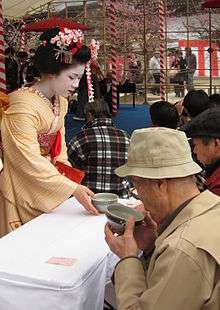
At the Kitano Tenman-gū shrine there is an annual open-air tea ceremony ("nodate" (野点)) during the plum-blossom festival ("baikasai" (梅花祭)) every February 25. During this ceremony, geisha and maiko from the Kamishichiken district in northwest Kyoto serve tea to 3,000 guests.[81][82] As of 2010, they also serve beer in a beer garden at the Kamishichiken Kaburenjo Theatre during the summer months.[83][84][85] Another geisha beer garden is available at the Gion Shinmonso ryokan in the Gion district.[83] These beer gardens also feature traditional dances by the geisha in the evenings.
Arts
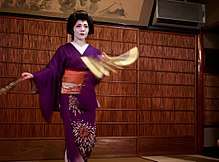
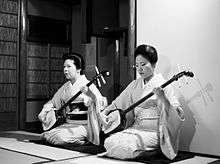
Geisha entertain their guests with a combination of both their hostessing and conversational skills, and their skills in traditional Japanese art forms of dance, music and singing. Before deciding to begin a career as a geisha, new recruits are generally expected to have an interest in the arts, as well as some experience; however, as geisha numbers have fallen throughout the decades, this is no longer a strict prerequisite. Some okiya will take on recruits with no previous experience, with some young geisha, despite having existing experience, expected to begin their lessons from the beginning.[4]:189
The style of dance practiced by geisha today evolved from dance styles used in both nōh and kabuki theatre. Over time, the more exaggerated theatrical styles evolved into the subtle and more stylised form of dancing used today; despite the difference, elements of traditional Japanese dance, such as the use of gestures to tell a story and the symbolism used to represent this, run throughout both as a common feature.[11]
These dances are accompanied by traditional Japanese music. The primary instrument used by geisha to accompany dance is the shamisen, a banjo-like three-stringed instrument played with a plectrum. Originating in China as the sanxian, it was introduced to Japan through firstly Korea, and then the Ryukyu Islands in the 1560s, obtaining its current form within a century. The shamisen soon became the mainstay instrument of geisha entertainment in the 1750s.[4]:258–259[86] It is described as having a distinct and melancholic sound, with traditional shamisen music using only minor thirds and sixths in its composition.[86]
All geisha must learn to play the shamisen, alongside additional instruments that often accompany the shamisen, such as the ko-tsuzumi (small shoulder drum) and fue (flute), during their apprenticeship, as well as learning traditional Japanese dance; however, after graduation to geisha status, geisha are free to choose which art form they wish to pursue primarily. Geisha who pursue musicianship are known as jikata geisha (地方, lit., "ground [seated, when playing instruments and singing] person"), whereas geisha who pursue dance are known as tachikata geisha (立方, lit., "standing person"). Some geisha not only dance and play music, but also write poems, paint pictures, or compose music.[11]
Appearance
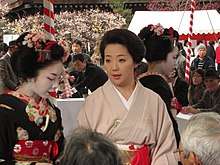
A geisha's appearance changes symbolically throughout her career, representing her training and seniority. These constitute changes in hairstyle, hair accessories, and kimono style.
Makeup
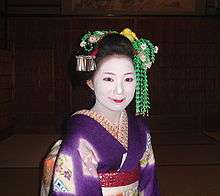
Both maiko and geisha wear traditional white foundation known as oshiroi; this is worn with red and black eye and eyebrow makeup, red lips and light pink blusher. Both maiko and geisha underpaint their lips with a red lipstick known as beni, but first-year apprentice geisha paint only the lower lip, and wear less black around the eyes and eyebrows than senior maiko. Younger apprentices may also paint their eyebrows slightly shorter or rounder to emphasise a youthful appearance.[87] Maiko wear noticeably more blush - known as tonoko - than geisha.[88] Young apprentices may have the mother of the house or their "older sister" mentors help them apply makeup.
Geisha wear more black around the eyes and eyebrows than maiko, and older geisha tend only to wear a full face of traditional white makeup during stage performances or on special occasions; older geisha generally stop wearing oshiroi around the same time they stop wearing hikizuri to parties.
For a short period before becoming a geisha, maiko in some geisha districts colour their teeth black, usually accompanied by wearing the sakkō hairstyle and a decorated black formal kimono. Teeth blackening was once a common practice amongst married women in Japan and the imperial court in earlier times, but is now an extremely uncommon practice.
Dress
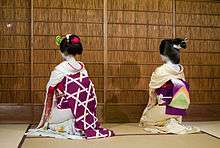
Geisha and maiko always wear kimono while working, and typically wear kimono outside of work. However, the type of kimono varies based on age, occasion, region and season of the year.
Maiko
Both maiko and geisha wear the collar on their kimono relatively far back, accentuating (for maiko) the red collar of the underkimono (juban), and displaying (for both) the two or three stripes of bare skin (eri-ashi and sanbon-ashi respectively) left just underneath the hairline when wearing oshiroi.
Apprentice geisha wear kimono known as hikizuri. Geisha also wear hikizuri; however, maiko wear a variety with furisode-style sleeves, with a tuck sewn into either sleeve, and a tuck sewn into each shoulder. Maiko hikizuri tend to be colourful and highly decorated, often featuring a design that continues inside the kimono's hem.
The style of this kimono varies throughout different regions; apprentices in Kyoto tend to wear large but sparsely-placed motifs, whereas apprentices elsewhere appear in kimono similar to a regular furisode, with small, busy patterns that cover a greater area.
Apprentices wear long, formal obi. For apprentices in Kyoto this is almost always a darari (lit., "dangling") obi, a style nearly 6 metres long, but elsewhere may be the shorter and narrower fukuro obi. Darari are always worn in a knot showing off the length, whereas apprentices elsewhere wear fukura-suzume and han-dara (lit., "half dangling") knots. When wearing casual kimono in off-duty settings, an apprentice may still wear a nagoya obi, even with a yukata.
Apprentices wear either zōri or okobo with their kimono, with okobo being worn (in Kyoto at least) with all formal kimono.[8] For training and in everyday life, zōri are worn, even when wearing casual short-sleeved kimono such as komon and yukata.
Geisha
Geisha wear kimono more subdued in pattern and colour than both regular kimono, and the kimono worn by apprentice geisha. A geisha always wear a short-sleeved kimono, regardless of occasion, formality, or even her age; however, not all geisha wear the hikizuri type of kimono, as older geisha wear regular formal kimono - with no trailing skirt, dipping collar or offset sleeves - to engagements. Regional geisha tend to have greater similarities with fellow geisha across the country in terms of appearance.
Geisha wear their obi in the nijuudaiko musubi style - a taiko musubi (drum knot) tied with a fukuro obi; geisha from Tokyo and Kanazawa also wear their obi in the yanagi musubi (willow knot) style and the tsunodashi musubi style. Though geisha may wear hakata ori obi in the summer months, geisha from Fukuoka - where the fabric originates from - may wear it the entire year.
Geisha exclusively wear solid white han-eri, and wear either geta or zōri when wearing kimono.
Hair
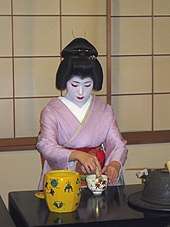
The hairstyles of geisha have varied throughout history. During the 17th century, the shimada hairstyle developed, which became the basis for the hairstyles worn by both geisha and maiko. When the profession of geisha first came into existence, dress edicts prevented geisha from wearing the dramatic hairstyles worn by courtesans, leading to the subdued nature of most geisha hairstyles.
Following WW2, many of the hairstylists who had previously served the karyūkai had been lost as war casualties, leading to the redevelopment of hairstyles for geisha and maiko. Geisha, unable to reliably book in with a hairstylist once a week to maintain their hair, began to wear human hair wigs in the shimada style that required restyling far less. The hairstyles of maiko, still utilising the apprentice's own hair, became wider, placed higher upon the head, and shorter in length.[89]
There are five different hairstyles that a maiko wears, which mark the different stages of her apprenticeship. The nihongami hairstyle with kanzashi hair ornaments are most closely associated with maiko,[90] who spend hours each week at the hairdresser and sleep on special pillows (takamakura) to preserve the elaborate styling.[49][91] Maiko can develop a bald spot on their crown caused by the stress of wearing these hairstyles almost every day, but in the present day, this is less likely to happen due to the later age at which maiko begin their apprenticeship. Maiko in certain districts of Kyoto may also wear additional, differing hairstyles in the run up to graduating as a geisha.
In the present day, geisha wear a variety of the shimada known as the tsubushi shimada - a flattened, sleeker version of the taka shimada worn as a bridal wig in traditional weddings. Though geisha also wear this hairstyle as a wig, it is usually shaped specifically to their face by a wig stylist.
Both the hairstyles of maiko and geisha are decorated with hair combs and hairpins (kanzashi), with geisha wearing far fewer kanzashi than maiko. The style and colour of hair accessories worn with some maiko hairstyles can signify the stage of an apprentice's training. Typical combs and hairpins may be made of tortoiseshell or mock-tortoiseshell, gold, silver and semi-precious stones such as jade and coral.
In popular culture
Geisha have been the subject of many films, books and television shows.
Films about geisha
- Sisters of the Gion (1936)—Dir. Kenji Mizoguchi
- The Life of Oharu (西鶴一代女 Saikaku Ichidai Onna) (1952)—Dir. Kenji Mizoguchi
- A Geisha (祇園囃子, Gion bayashi) (1953)—Dir. Kenji Mizoguchi
- The Teahouse of the August Moon (1956)—Dir. Daniel Mann
- The Barbarian and the Geisha (1958)—Dir. John Huston
- The Geisha Boy (1958)—Dir. Frank Tashlin
- Late Chrysanthemums (Bangiku) (1958)—Dir. Mikio Naruse
- Cry for Happy (1961)—George Marshall comedy
- My Geisha (1962)—Dir. Jack Cardiff
- The Wolves (1971)—Dir. Hideo Gosha
- The World of Geisha (1973)—Dir. Tatsumi Kumashiro
- In the Realm of the Senses (1976)—Dir. Nagisa Oshima
- Ihara Saikaku Koshoku Ichidai Otoko (1991)—Dir. Yukio Abe
- The Geisha House (1999)—Dir. Kinji Fukasaku
- The Sea is Watching (2002)—Dir. Kei Kumai
- Zatoichi (2003)—Dir. Takeshi Kitano
- Fighter in the Wind (2004)—Dir. Yang Yun-ho
- Memoirs of a Geisha (2005)—Dir. Rob Marshall
- Wakeful Nights (2005)—Dir. Masahiko Tsugawa
- Maiko Haaaan!!! (2007)—Dir. Nobuo Mizuta
- Lady Maiko (2014)—Dir. Masayuki Suo
Video games featuring geisha
- Total War: Shogun 2 (Used as agent to assassinate or seduce enemy clans)
- Battle Realms (Used as healers by Dragon Clan And Serpent Clan)
See also
- Ca trù, a similar profession in Vietnam
- Hanayo
- Kanhopatra
- Kisaeng, a similar profession in Korea
- Taikomochi
- Tawaif, a similar profession in India
- Yiji, a similar profession in China
- Binukot,[92] a similar profession in the Philippines
References
- "How to pronounce geisha". forvo.com. Forvo Media. Retrieved 1 June 2020.
- "English geisha translations". ezglot.com. E-Z-Glot. Retrieved 1 June 2020.
- Masuda, Sayo (2003). Autobiography of a Geisha. Translated by Rowley, G. G. New York: Columbia University Press. ISBN 0-231-12951-3.
- Dalby, Liza (2000). Geisha (3rd ed.). London: Vintage Random House. ISBN 0099286386.
- "The Life of a Geisha". toki.tokyo. Toki Tokyo. Retrieved 1 June 2020.
- Downer, Lesley (2003). "Prologue - In Search of Sadayakko". Madame Sadayakko: The Geisha Who Bewitched the West. New York: Gotham Books. pp. 5–6. ISBN 978-1422360293.
- Dalby, Liza. "newgeishanotes". lizadalby.com. Liza Dalby. Retrieved 30 May 2020.
- Gallagher, John (2003). Geisha: A Unique World of Tradition, Elegance, and Art. London: PRC. ISBN 1-85648-697-4.
- Patrick, Neil (16 May 2016). "The Rise of the Geisha - photos from 19th & 20th century show the Japanese entertainers". The Vintage News. Retrieved 6 November 2017.
- "History of geisha". Japan Zone. Retrieved 18 June 2010.
- Downer, Lesley (23 March 2006). "The City Geisha and Their Role in Modern Japan: Anomaly or artistes". In Feldman, Martha; Gordon, Bonnie (eds.). The Courtesan's Arts: Cross-Cultural Perspectives. New York: Oxford University Press, USA. pp. 223–242. ISBN 978-0-19-517029-0.
- Fujimoto, Taizo (1917). The Story of the Geisha Girl. p. 18. ISBN 978-1-4086-9684-2.
- Seigle, C. S. (March 1993) [1931]. "Rise of the Geisha". Yoshiwara: the glittering world of the Japanese courtesan (illustrated ed.). University of Hawaii Press. p. 171. ISBN 978-0-8248-1488-5.
- Fiorillo, J. "Osaka Prints: Glossary".
geiko: "Arts child", originally dancing girls who were too young to be called geisha but too old (more than twenty years of age) to be called odoriko. "Geiko" was the pronunciation used in the Kamigata region. Some geiko operated as illegal sex workers. By the nineteenth century the term became synonymous with geisha.
- Tiefenbrun, S. (2003). "Copyright Infringement, Sex Trafficking, and the Fictional Life of a Geisha". Michigan Journal of Gender & Law. 10: 32. doi:10.2139/ssrn.460747. SSRN 460747.
- Gallagher, J. (October 2003). "Appendix II a timeline of geisha and related history". Geisha: a unique world of tradition, elegance, and art. PRC Publishing. p. 252. ISBN 978-1-85648-697-2.—Gallagher says that "Kiku" from Fukugawa district founded the profession in 1750, and that by 1753 one hundred odoriko were consigned to Yoshiwara, which licensed (female) Geisha in 1761.
- Seigle, Cecilia Segawa (1931). Yoshiwara: The Glittering World of the Japanese Courtesan. University of Hawaii Press. pp. 172–174. Archived from the original on 13 June 2011. Retrieved 22 September 2018.
- Eichman, Shawn. "Tongue in Cheek: Erotic Art of 19th Century Japan" (Online museum exhibition). honolulumuseum.org. Honolulu Museum of Art. Retrieved 30 May 2020.
Though the precise reasons for [the decline] in the public’s perception of the Yoshiwara [Edo brothel district] during the 19th century can only be speculated, the decline was as precipitous as it was undeniable. By the early 20th century, the aura of dignity and élan the courtesans had once exuded was all but lost, and these women, many of whom suffered from venereal disease, appeared more like sexual slaves than celebrities. (page 102)
- Dalby, Liza. "The paradox of modernity". Geisha. p. 74. OCLC 260152400.
- Ohnuki-Tierney, E. (October 2002). Kamikaze, Cherry Blossoms, and Nationalisms: The Militarization of Aesthetics in Japanese History. University Of Chicago Press. p. 347. ISBN 978-0-226-62091-6.
- Dougill, John (2006). Kyoto: a cultural history. Oxford University Press. p. 182. ISBN 0-19-530137-4.
- Reynolds, Wayne; Gallagher, John (2003). Geisha: A Unique World of Tradition, Elegance, and Art. PRC Publishing. p. 135. ISBN 1-85648-697-4.
- Dalby, Liza. "Do They or Don't They". lizadalby.com. Retrieved 12 January 2010.
The question always comes up...just how 'available' is a geisha? ... There is no simple answer.
- "Goodby to Geisha Girl, She's on Her Way Out". The Ogden Standard-Examiner. Ogden, Utah. 27 September 1959. Retrieved 16 October 2019.
- Taubman, Howard (June 12, 1968). "Geisha Tradition Is Bowing Out in Japan; Geishas Fighting Losing Battle Against New Trends in Japan". The New York Times. p. 49. Retrieved March 16, 2011.
- Weisman, Steven R. "Ex-Geisha Accuses Uno Of a Dangerous Liaison". The New York Times. nytimes.com. Retrieved 3 June 2020.
- Kalman, Bobbie (March 1989). Japan the Culture. Stevens Point, Wisconsin: Crabtree Publishing Company. ISBN 0-86505-206-9.
- Lies, Elaine (23 April 2008). "Modern-day geisha triumphs in closed, traditional world". Reuters. Retrieved 2 June 2009.
- "World's oldest geisha looks to future to preserve past". AsiaOne. 3 December 2007. Archived from the original on 4 March 2008.
An economic downturn in the 1990s forced businessmen to cut back on entertainment expenses, while high-profile scandals in recent years have made politicians eschew excessive spending. A dinner can cost around 80,000 yen (US$1,058) per head, depending on the venue and the number of geishas present. But even before the 90s, men were steadily giving up on late-night parties at ryotei, restaurants with traditional straw-mat tatami rooms where geishas entertain, in favour of the modern comforts of hostess bars and karaoke rooms.
- Buzzfeed Japan. "トップ芸妓が語る仕事の流儀と淡い恋 「いまから思うと好きやったんかな?」". headlines.yahoo.co.jp (in Japanese). Yahoo Japan. Retrieved 20 March 2020.
- Demetriou, Danielle (30 December 2008). "Tourists warned to stop 'harassing' Kyoto's geisha". The Daily Telegraph. Retrieved 22 September 2018.
- Dalby—Geisha 2008 pp. 17–18.
- Geisha 2008 pp. 18, 77, 148.
- Dalby, Liza. "newgeishanotes". lizadalby.com. Liza Dalby. Retrieved 21 October 2019.
Reference 12
- "World's oldest geisha looks to future to preserve past". 3 December 2007. Archived from the original on 19 October 2012. Retrieved 23 June 2010.
Girls in the past could become apprentice geishas from the age of 13, but it is now illegal to become an apprentice before 18 except in Kyoto where a girl can be an apprentice at 15.
- Prasso, Sheridan (May 2006). "The Real Memoirs of Geisha". The Asian Mystique: Dragon Ladies, Geisha Girls, and Our Fantasies of the Exotic Orient. p. 218. ISBN 978-1-58648-394-4.
- Jones, N. (20 April 2007). "Japan's geisha hit by poor economy". The Washington Times.
now more [university] students are interested in becoming geisha
- Tames, Richard (September 1993). A Traveller's History of Japan. Brooklyn, New York: Interlink Books. ISBN 1-56656-138-8.
- Iwasaki, Mineko; Brown Ouchi, Rande (October 2002). Geisha: A Life (first ed.). Atria. p. 132. ISBN 978-0-7434-4432-3.
- Kalman, B. (2008). Japan the Culture. p. 29. ISBN 978-0-7787-9298-7.
- McCurry, J. (11 December 2005). "Career geisha outgrow the stereotype, page 2". The Age. Melbourne. Retrieved 21 June 2010.
- Coutsoukis, Photius (10 November 2004). "Japan Performing Arts". Retrieved 2 June 2009. Originally from The Library of Congress Country Studies; CIA World Factbook.
- Coutsoukis, Photius (10 November 2004). "Japan Dance". Retrieved 2 June 2009. Originally from The Library of Congress Country Studies; CIA World Factbook.
- Melissa Hope Ditmore (2006). Encyclopedia of prostitution and sex work. Westport, Conn: Greenwood Press. ISBN 0-313-32969-9., page 184
- Reynolds, Wayne; Gallagher, John (2003). Geisha: A Unique World of Tradition, Elegance and Art. PRC Publishing. p. 159. ISBN 1-85648-697-4.
- Jones, N. (20 April 2007). "Japan's geisha hit by poor economy". The Washington Times.
Even the older sisters who became geisha as teenagers, they are [now] over 80 but still train every day
- Dalby, Liza Crihfield (2008-12-10). Geisha. ISBN 9780520257894. OCLC 225871480.
- Rahayu, Mundi; Emelda, Lia; Aisyah, Siti (2014-11-01). "Power Relation In Memoirs Of Geisha And The Dancer". Register Journal. 7 (2): 151. doi:10.18326/rgt.v7i2.213. ISSN 2503-040X.
- McCurry, J. (11 December 2005). "Career geisha outgrow the stereotype". The Age. Melbourne. p. 3. Retrieved 21 June 2010.
- Wieder, Tamara (17 October 2002). "Remaking a memoir". Boston Phoenix. Archived from the original on 6 January 2010. Retrieved 12 January 2010.
- Iwasaki, Mineko (2002). Geisha : a life. Ouchi, Rande Brown. New York: Atria Books. ISBN 0743444329. OCLC 50414454.
- Collins, Sarah (24 December 2007). "Japanese Feminism". Serendip Studio. Archived from the original on 12 October 2009. Retrieved 12 January 2010.
- Mineko, Iwasaki; Brown, Rande (2003). Geisha, A Life. New York: Washington Square.
- Stanley, Amy (August 2013). "Enlightenment Geisha: The Sex Trade, Education, and Feminine Ideals in Early Meiji Japan". The Journal of Asian Studies. 72 (3): 539–562. doi:10.1017/S0021911813000570. ISSN 0021-9118.
- Matsugu, Miho (2006). "In the Service of the Nation: Geisha and Kawabata Yasunari's 'Snow Country'". In Feldman, Martha; Gordon, Bonnie (eds.). The Courtesan's Arts: Cross-Cultural Perspectives. London: Oxford University Press. p. 244. ISBN 0-19-517028-8.
- Prasso, Sheridan (April 2009). The Asian Mystique: Dragon Ladies, Geisha Girls, and Our Fantasies of the Exotic Orient. New York: Public Affairs. p. 52. ISBN 978-1-58648-214-5.
- Henshall, K. G. (1999). A History of Japan. London: Macmillan Press. p. 61. ISBN 0-333-74940-5.
- Prasso, Sheridan. "The Asian Mystique." New York: Public Affairs, 2005:206
- Ozeki, R. (2005). Inside and other short fiction: Japanese women by Japanese women. Kodansha International. ISBN 4-7700-3006-1.
- Booth, Alan (1995). Looking for the Lost: Journeys Through a Vanishing Japan. Kodansha Globe Series. ISBN 1-56836-148-3.
- Dalby, L. (February 2009). "Waters dry up". East Wind Melts the Ice: A Memoir through the Seasons by Liza Dalby. University of California Press. pp. 190–191. ISBN 978-0-520-25991-1.
The resulting official line that geisha live by art alone is unrealistically prudish.
- "World War II and the American Occupation". Geisha of Japan.com.
- Dalby, Liza (2000). Geisha (3rd ed.). London: Vintage Random House. p. 115. ISBN 0099286386. Retrieved 12 March 2020.
- Hyslop, Leah (4 October 2010). "Liza Dalby, the blue-eyed geisha". The Daily Telegraph. London. Retrieved 18 July 2011.
- Liza, Dalby (1983). Geisha. London: Vintage U.K. pp. 106–109. ISBN 9780099286387.
- Gilhooly, Rob (23 July 2011). "Romanian woman thrives as geisha". The Japan Times. Tokyo. Retrieved 26 October 2014.
- Yaguchi, Ai. "愛知。安城の花柳界で活躍する西洋人芸妓" [Western geisha active in the flower and willow world in Anjō] (in Japanese). Retrieved 14 July 2019.
- "一駒寮". ichicoma.com (in Japanese). Ichikoma Okiya. Archived from the original on 14 March 2012. Retrieved 21 June 2020.
- Топкова, Анна (19 January 2012). "Гейша". Женский журнал Мурана (in Russian) (15). Archived from the original on 23 June 2020. Retrieved 23 June 2020.
- "新しいお仲間さん♪". ameblo.jp (in Japanese). 愛知県安城市 置屋『一駒寮』の裏方人?. Archived from the original on 1 July 2012. Retrieved 23 June 2020.CS1 maint: unfit url (link)
- "節分 お化け♪ お座敷編". ameblo.jp (in Japanese). Ikoma Co., Ltd. Archived from the original on 2 February 2012. Retrieved 21 June 2020.
- Adalid, Aileen. "Understanding the Geisha of Japan: What They Truly Are, Where to See Them, and More!". iamaileen.com. Aileen Adalid. Archived from the original on 10 October 2016. Retrieved 23 June 2020.
[first snapshot of this article listing Ibu as retired]
- Yugawara Geiko. "「新花」の「樹里」さん" ["Juri" of "Shinka"]. Yugawara Onsen Fukiya Young Girl's Blog (in Japanese). Yugawara Onsen. Retrieved 14 July 2019.
- Adalid, Aileen. "Up Close & Personal with Kimicho, an American Geisha in Tokyo, Japan". iamaileen. Aileen Adalid. Retrieved 14 July 2019.
- Oh, Hyun. "The Apprentice: Memoirs of a Chinese geisha wannabe in Japan". Reuters. Thomson Reuters Corporation. Retrieved 14 July 2019.
- "Melbourne woman becomes a geisha". 9 News. Ninemsn Pty Ltd. 8 January 2008. Archived from the original on 5 October 2012. Retrieved 14 October 2018.
- "Keeping a tradition alive, from the outside in". Bangkok post. Post Publishing PCL. 25 October 2018. Retrieved 15 March 2019.
- 外国人芸者 独立はダメ 浅草の組合「想定外」 [Foreign geisha denied independence - Association talk of ‘unexpected events’]. Tokyo Shimbun (in Japanese). Japan: Tokyo Shimbun. 7 June 2011. Archived from the original on 7 June 2011. Retrieved 28 August 2016.
- "Maiko Dance". Into Japan. Archived from the original on 2012-03-27. Retrieved 2012-03-26.
- "Geisha dances". Geisha of Japan. Archived from the original on 2 January 2013.
- "Baika-sai (Plum Festival)". Kyoto Travel Guide. Archived from the original on 20 January 2011. Retrieved 22 September 2018.
- "Open-Air Tea Ceremony with the Scent of Plum Blossoms: Plum Blossom Festival at Kitano Tenman-gu Shrine". Kyoto Shimbun. 25 February 2007. Archived from the original on 30 September 2011. Retrieved 16 September 2018.
- Demetriou, Danielle (16 July 2010). "Geishas serve beer instead of tea and conversation as downturn hits Japan". The Daily Telegraph.
- "Geisha beer garden opens in Kyoto". The Sydney Morning Herald. 9 July 2010.
- "Geisha gardens in Kyoto". Travelbite.co.uk. 12 July 2010. Archived from the original on 12 August 2010. Retrieved 22 September 2018.
- Maske, Andrew L. (2004). Geisha: Beyond the Painted Smile. Peabody: Peabody Essex Museum. p. 104.
- Prasso, Sheridan (2006). The Asian Mystique: Dragon Ladies, Geisha Girls & Our Fantasies of the Exotic Orient (2nd ed.). New York: Perseus Book Group. ISBN 9780786736324.
- Tetsuo, Ishihara (2001). Nihongami no sekai - The world of traditional Japanese hairstyles. Kyoto: Nihongami Shiryōkan. pp. 66–71.
- "A Week in the Life of: Koaki, Apprentice Geisha – Schooled in the arts of pleasure". The Independent. London. 8 August 1998.
- Tetsuo, I. Nihongami no sekai [The World of traditional hairstyles and hair ornaments]. Nihongami Shiryōkan. ISBN 4-9902186-1-2.
- Layton, J. "Dressing as a Geisha". howstuffworks.com.
- Santos, Mari. "'You look like the help': the disturbing link between Asian skin color and status". Splinter. Retrieved 2019-03-18.
Further reading
- Aihara, Kyoko. Geisha: A Living Tradition. London: Carlton Books, 2000. ISBN 1-85868-937-6, ISBN 1-85868-970-8.
- Ariyoshi Sawako, The Twilight Years. Translated by Mildred Tahara. New York: Kodansha America, 1987.
- Burns, Stanley B., and Elizabeth A. Burns. Geisha: A Photographic History, 1872–1912. Brooklyn, N.Y.: powerHouse Books, 2006. ISBN 1-57687-336-6.
- Downer, Lesley. Women of the Pleasure Quarters: The Secret History of the Geisha. New York: Broadway Books, 2001. ISBN 0-7679-0489-3, ISBN 0-7679-0490-7.
- Foreman, Kelly. "The Gei of Geisha. Music, Identity, and Meaning." London: Ashgate Press, 2008.
- Ishihara, Tetsuo. Peter MacIntosh, trans. Nihongami no Sekai: Maiko no Kamigata (The World of Traditional Japanese Hairstyles: Hairstyles of the Maiko). Kyoto: Dohosha Shuppan, 2004. ISBN 4-8104-1294-6.
- Iwasaki, Mineko, with Rande Brown. Geisha, A Life (also known as Geisha of Gion). New York: Atria Books, 2002. ISBN 0-7434-4432-9, ISBN 0-7567-8161-2; ISBN 0-7434-3059-X.
- Scott, A.C. The Flower and Willow World; The Story of the Geisha. New York: Orion Press, 1960.
External links
| Look up 芸者 or geisha in Wiktionary, the free dictionary. |

- Nagoya Traditional Performing Arts Association
- WayBack Machine captures of the Immortal Geisha forum and website